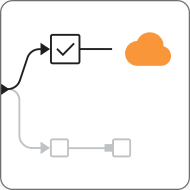Fuzzy Name Matching with KNIME
Inconsistencies in name spelling across systems can obscure links between related records—such as duplicated vendors, shell entities, or fragmented customer histories. Fuzzy name matching helps auditors uncover these connections by identifying approximate matches between names that differ slightly. With KNIME, you can build transparent, flexible workflows to identify similar names, reduce duplication, and improve data quality.
KNIME Workflow Example for Fuzzy Name Matching
This example workflow illustrates how to uncover fuzzy matches in a vendor name dataset by measuring string similarities and grouping together entries with closely related names. It includes:
- Data access and validation tests, such as string checks and missing value verification to ensure that all values conform to the expected format and data type.
- String distance computation and clustering for the automated detection and grouping of name variations for a given vendor.
- An interactive dashboard that allows users to review fuzzy matches, distance scores and cluster assignments, complemented by a static summary report for ease of sharing and documentation.
Why use KNIME for Fuzzy Name Matching

What is Fuzzy Name Matching?
Fuzzy name matching (or approximate string matching) is the task of identifying when two name strings refer to the same real-world entity, even if they differ due to typos, abbreviations, transposed characters, or other small differences (e.g. “Jon Smith” vs “John Smithe”, or “Müller” vs “Mueller”). It typically relies on string similarity metrics (e.g., Levenshtein distance, Jaro–Winkler distance, N-gram Tversky index) to assess how “close” two names are.

Why does it matter?
Fuzzy name matching is important because slight spelling differences can disrupt key data processes. During data integration or mergers, these inconsistencies can prevent valid matches across systems. Within a single dataset, they can lead to duplicate records and reporting errors. Clean identity records in Master Data Management (MDM) efforts also depend on resolving such variations. In risk, compliance, and fraud detection, fuzzy matching is often necessary to align internal data with external lists like sanctions or watchlists, where exact matches may not exist.

Typical challenges
- Common names can easily produce incorrect matches without sufficient contextual data to differentiate them.
- Variations in accents, punctuation, casing, and abbreviations require careful preprocessing to avoid mismatches.
- Deciding on a similarity threshold that balances missed matches with false positives can be difficult, especially when names are short or ambiguous.
- Matching large datasets can become computationally intensive, particularly when every record needs to be compared with every other.

Benefits of using KNIME
- Data from Excel, CSV, databases, SAP, Snowflake, and other sources can be easily accessed and combined into a single, end-to-end process.
- A broad range of data manipulation nodes helps with string cleaning and transformation, such as trimming, tokenizing, removing accents, or standardizing formats.
- Different string similarity methods—such as Levenshtein and Jaro–Winkler Distance, or N-gram Tversky index—are available to facilitate test and comparison.
- Visual, modular workflows let you control preprocessing, joining, similarity scoring, and filtering in a transparent and traceable way.
- Workflows can be deployed on KNIME Hub, enabling automated execution, version control, and secure sharing across teams.
How to use KNIME for Fuzzy Name Matching

Data Access and Preparation
Import datasets such as customer lists, supplier directories, or institution records directly into KNIME from sources like SAP, Oracle, Snowflake, Excel, or CSV. Leverage data manipulation and string processing nodes (e.g., Expression, String Manipulation, String Cleaner, Missing Value) to remove duplicates, normalize name fields by trimming spaces, converting case, standardizing abbreviations (“Inc.” vs “Incorporated”), and handling missing values. This preparation ensures the data is clean and easier to compare.

Identify and Match Fuzzy Names
Compute string distance scores to identify variations and near matches across datasets using algorithms, such as Levenshtein Distance or Jaro–Winkler Distance. Adjust similarity thresholds to optimize match accuracy for your specific data characteristics. Enhance results by applying clustering techniques to automatically group closely related strings, filter out low-confidence matches, and clearly flag ambiguous or uncertain cases for review.

Result Review and Automation
Display potential name matches and similarity scores in an interactive dashboard or share results through a static report for human validation. Automate the entire workflow using KNIME Hub—scheduling periodic runs to continuously detect fuzzy entries or inconsistencies as data updates. Integrate seamlessly with enterprise systems (e.g., SAP, Oracle, CRM platforms) to maintain synchronized and deduplicated master data, reducing manual reconciliation and ensuring data reliability over time.
How to Get Started
Additional Resources
KNIME for Auditors
A guide for auditors who are familiar with ACL and IDEA and are ready to explore KNIME Analytics Platform.
10 Ready-to-Use Audit Test Workflows: KNIME for Audit
Learn how each audit test in the KNIME Audit Starter Pack helps you identify risks, automate analysis, and improve audit efficiency.
FAQ
There is no one‑size‑fits‑all. You should experiment with your data by manually inspecting borderline matches. Try out lower similarity thresholds initially (e.g., 80–85%), review and iterate to avoid missing any critical matches. Also consider combining name similarity with additional fields (e.g., address, city) to enhance match reliability.
Yes, but you will first need normalization steps: adjust character encoding, strip accents, transliterate characters, map alternate spellings, etc. In many cases, convert names into a canonical representation (e.g., “Müller” → “Muller”) before matching.
You can keep top‑k matches (e.g., top 3), then apply business rules (e.g., prefer the same region, additional field proximity), or flag these ambiguous cases for manual review.
It is broadly applicable to any string-based identifiers where spelling or formatting may differ—company names, product names, addresses, etc.
Yes. After building your workflow in KNIME Analytics Platform, you can deploy it using one of KNIME’s paid plans to enable scheduled execution, automated data updates and alerts, and secure team sharing. This ensures fast, consistent, and repeatable fuzzy matching operations across audits and data quality processes.